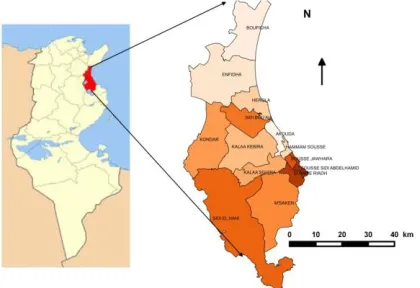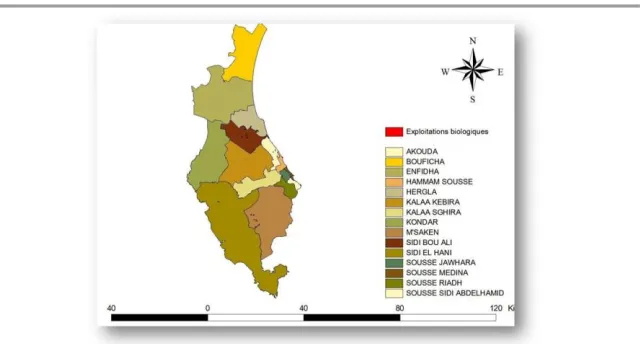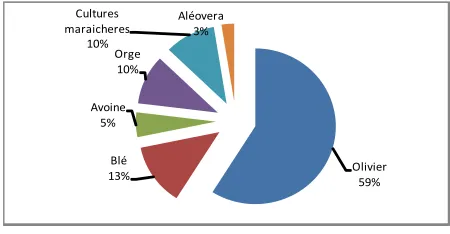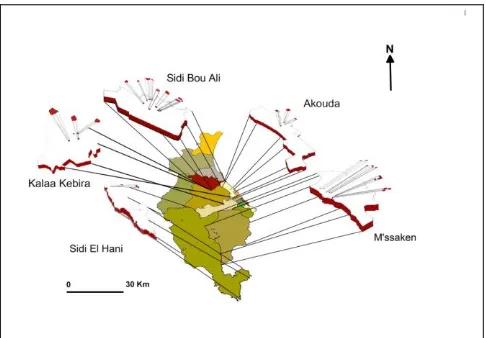ISSN 2286-4822
www.euacademic.org DRJI Value: 5.9 (B+)
Using Google Earth and Mobile GPS to Assess and
Map the Spatial Distribution of Organic Farming.
The Case of Sousse Governorate -Tunisia
FAIZA KHEBOUR ALLOUCHE Assistant Professor ISA – IRESA - University of Sousse Tunisia AKRAM CHAMSI Engineer of Horticulture ISA-Sousse, Tunisia NAIMA OSMAN LAAJIMI General Engineer of Organic Agriculture
CRDA-Sousse, Tunisia HENEM GRISSA BALAAZI General Engineer of Organic Agriculture CTAB-Sousse, Tunisia
Abstract:
M'ssaken. This organic farming crops characteristics of the region are dominated by arboriculture, precisely, olive culture with a percentage of 59 % followed by cereal fields (28 %). So the organic farming is not yet developed and according to the owners, socio-cultural and economic are the main limit factors of its development.
Key words: organic farming, Google earth, GPS, map, Geographic Information Systems (GIS).
1. Introduction
Sustainable agriculture includes agricultural systems that promote the environmentally, socially and economically sound production of food and fiber (Agboh-Noameshie & Al-Ajjawi, 2004). Organic production, as defined by the USDA National Organic Program, is “a system that is managed in accordance with the (NOP) Act and regulations in this part to respond to site-specific conditions by integrating cultural, biological, and mechanical practices that foster cycling of resources, promote ecological balance, and conserve biodiversity. “(USDA NOP, 2004).
Unlike conventional agriculture, organic farming is characterized by a wide variety of agricultural practices adapted to local conditions. It is considered a form of agriculture with benefits for the environment, such as reducing human diseases related to pesticide use and food security through diversification of families’ diet, improving water quality and reducing the costs of his treatment (Petit, 2013).
operating in a small area, which represent about 75 % of organic farmers around the world (Journeau, 2013).
At the national level, organic farming is well developed due to the Tunisian state efforts to promote this sector and expand into new markets. The establishment of laws, decrees and orders governing organic farming from 1999, precisely the enactment of Law No. 30 of April 5th, started the development
of this agriculture. This regulation organize all phases of the preparation for certification, the certification itself and covers all production activities until the arrival of the final product to consumers. They also maintain the relationship between operator certification, the state, and the various market agents (JORT, 1999). On the other hand, a national strategy development has resulted in many achievements, including the creation of specific research structures such as the Technical Centre for Biological Agriculture (CTAB) and Regional Centre for Research in Horticulture and Organic Agriculture (CRRHAB) whose headquarters at Chott Meriem, Sousse.
According to the DGAB (2013), biological agricultural area in Tunisia occupies 71 % of the total organic area in 2012 so 139 873 ha, while the forests and wild plants hold 29 %, that means a third of the total area estimated at 196 918 ha. The number of operator has also increased to a total of 2,523 stakeholders in the biologic agriculture sector. Currently five certification bodies perform their duties in Tunisia among which cites ECOCERT, CCBP, BCS, Soulo E Salute and INNOPRI (CTAB, 2013). The distribution of the organic farming recorded in 2012 shows a dominance of tree crops with a percentage of 74.64 %, of which 92.22 % are olive trees, followed by courses with 11.64 %. However, uncultivated land and fallow occupy 10.25 % this surfaces.
geographic, economic and social factors distribution. Nevertheless, this type of knowledge is dependent on a good collected data and their integration into a digital database. Hence, the use of high resolution images free access (source Google Earth) for mapping the organic farming plots at Sousse governorate.
The study area is located in eastern costal zones (35° 49' 32" North, 10° 38' 28" East) of Tunisia with an area of 2 669 km² (Figure. 1). Sousse Governorate includes 16 delegations, 16 towns and 8 rural councils. It is characterized by mild-cold winters and semi-arid continental climate with an average annual rainfall of 401,3 mm (for the period 2009-2013, in Sousse Station), with a minimum and a maximum average annual temperature of 12.74 °C and 38.48 °C. But, the low rainfall is compensated by atmospheric moisture and the aridity is defined by the scarcity and irregularity of showers and aggressiveness of wind and rain.
The soils are poorly developed along wadis and isohumic or brown limestone are located in steppe zone. Agricultural land in the governorate of Sousse covers 264.6 miles hectares of which 158.9 miles hectares are arable. However, the irrigated area is estimated at 11,834 ha and the most agricultural lands were irrigated with “Nebhana dam water”.
2. Material and methods
2.1. Data processing and software used
Data which was collected through site investigation. For instance, using Global Positioning System (GPS), and collection of spatial data from organic farming are typically necessary for spatial database construction. This method involves pre-field work database generation. To map plot level data, high resolution satellite images was needed. For this survey, Google earth images were used. To identify plot data on ground Garmin GPS was used. For database generation, processing and analysis purpose ArcGIS v 9.3 software was used. Four shape files were extracted from the Sousse Ministry of Agriculture such as: administration, sol, water resources and land use.
2.2. Farmers investigation
The objective of this survey is to locate and characterize the organic plots of Sousse, then to obtain a clear main factors that led these farmers choose of organic conducting and their future projections. The survey preparation phase is used to acquire the knowledge and information necessary for the implementation of the survey methodology. The questionnaire, is done logically, opened at the beginning and semi-structured in the end. The duration of the survey is of 10 minutes per questionnaire. Farmers are generally surveyed during good times that is to say, during the times when they are most receptive. It is for this reason, then appointments have been made in advance.
grouped into two parts: i) general information about the farmer, ii) general information on organic plots (land use, certification etc).
Before developing a questionnaire that will meet our target in advance, the distribution of the organic certifications were studied with the help of CRDA-Sousse engineers and from organic agriculture division to determine the number of farmers to investigate. So, the total number of surveyed farmers is 12 set in 5 delegations.
2.3. Data treatment
Figure2. Samples of plot digitizing in Google Earth
3. Results
3.1. Mapping Sousse organic farming
Figure 3.Spatial distribution of all organic plots in the governorate of Sousse
Figure 4 shows that from 39 organic plots, 76 % are located in the delegations of Sidi Bou Ali and M'ssaken with 14 plots for each. Only six organic farms are located in the delegation of Akouda, five in the delegation of Kalaa Kebira and a single parcel in the delegation of Sidi El Hani. This uneven distribution between delegations can be explained by the fact that the majority of organic farms have fallen under a family setting.
Figure 4. Organic farming percentage in Sousse delegations
Organic farming crops characteristics of the region are dominated by arboriculture, precisely, olive culture with a percentage of 59 % followed by cereal fields (28 %) : this rate is divided into 10 % intended for the cultivation of barley, 5 % for oats and 13% for wheat. The vegetable crops occupy 10 % of the total area of organic farmland, while the culture of aleovera is practiced only with a rate of 3 %. However, animal speculation is totally absent in these farms (Figure 5).
Olivier 59% Blé
13% Avoine
5% Orge
10% Cultures maraicheres
10%
Aléovera 3%
Figure5. Organic farming land use in Sousse
including humidity of coastal areas and the requirement of cultivated species for fertilization. However, organic farms where olive growing is practiced, are traditional cultures where forms of intensification (mechanization, health treatments and fertilization) are negligible or absent. This explains their high capacity for conversion, precisely, the speed of the certification procedure.
3.2. Mapping Spatial distribution of organic farming Figure 6 shows the spatial distribution mapping of organic farming in Sousse Governorate and contains five maps and Figure 7 presents the spatial location of plots organic farming per delegation.
Figure 6. Spatial distribution mapping of Sousse Organic farming
unsophisticated filler, calcareous brown soils and soil halomorphe are present.
The certification was mass for all parcels in 2010 and according to the interview with farmers, they think will orient their farms to grain farming. This conversion is related to climatic conditions, mainly rising temperatures, poor water quality and it is not available. Other plots with the same characteristics as those converted to organic methods, have significant potential conversion inside surface.
The delegation of Sidi Bou Ali owns 14 parcels from 39 existing organic farming. These farms belong to the same family under the leadership of several members. Their massive entry in the biological area was through a Tunisian investor that has a biological oil mill located near these plots. The common interest between the family and the businessman has facilitated the conviction of the remaining members of the family and the investor still a part of its neighbors. The lack of animal speculation or its presence in low rate does not represent a net production activity or even livestock. This is mainly due to personal precautions adopted by each owner according to his perception of the components of the project.
Since these farms are of small size ( not exceeding 10 hectares), the introduction of breeding activity is not possible, estimated area of perspective for the installation of housing and expenses productions that s 'added. The cost factor input is pushed to its limits by changing the driving mode. And even under organically, use of organic fertilizers is still limited. However, the market seems satisfied with the resulting production which encourages owners to pursue organic and even convince neighbors to adopt this mode of conduct.
opportunities or even a market lacking to convince those owners who have no objection to the conversion once the estimated gain is assured.
Organic farms which are located in Akouda delegation are state properties managed by all institutions which include the CTAB, the CRRHAB and ISA CM located in the Chott Mariem region. These plots are intended for experimentation and extend over an area of 16.5 hectares distributed as follows: - 4 hectares different between vegetable crops and citrus under the direction of CTAB.
- 5 ha different between orchards and vegetable crops under the direction of CRRHAB
- 4 ha of olive and 3.5 ha of vegetable crops established in Higher Institute for Agronomic Chott Meriem
About the nature of the vegetation cover of organic farms, we have not been able to draw accurate map of the land as these plots are the experimental scale. However, the institutions responsible for this biological agriculture confirmed that these rotations depend mainly on research strategies.
Kalaa Kebira delegation located in the center of the governorate of Sousse, holds 5 organic plots covering an area of 19 hectares are located in the Northwest and center of the delegation. They were converted en masse during 2010 certification body. The 3 owners are of local origin usse and practice agriculture from a young age, but have no finished high school. This partly explains their limited knowledge about different cultural practices can be adopted organically. About existing speculations on these farms, we recorded the absence of any breeding activity. The vegetation is characterized by the presence of the trees and cereals. This orientation is due to the precautions taken by these farmers, limiting the spending diversification of organic products.
Aleovera and belongs to a foreign investor. This organic farm is conducted with an intensive culture with a spacing of 0.6 m between plants and benefits with irrigation and workers (permanent and seasonal). Specially, this plot was divided into three lots of 5 hectares that are separated by wind tree breezes. The certification was achieved in 2012 following the request of the foreign investor, which has an international production in French market and has a processing plant located on the main road of Chott Mariem.
M’saken Sidi Bou Ali
Akouda Kalaa Kebira
Sidi Heni
Figure7. Spatial distribution of plots organic farming per delegation
4. Discussion
- Lack of livestock is due to the choice of uni-disciplinary investment farmers who limit speculation in plant and induces an increase in purchase costs of inputs such as compost.
- The fragmented nature is characterized by small areas and the estimated high cost farmers fodder is also constraints on farming.
- Cultivation practices, that is to say, the forms of intensification, are reduced notably mechanization and the introduction of organic fertilizers which facilitates conversion and shortened the conversion time.
- The land fragmentation characterizes these farms to the inheritance system from one generation to another, reduces the size of the farm by dividing it between the heirs.
- The geographical dispersion disproportionately between delegation due to condensation of family-type projects in the same areas.
- The dominance of family-oriented properties for pipes organically.
Based on this work mapping organic plots in the governorate of Sousse, it turns out that organic farming is not yet developed. However, according to the owners two main factors limit the development of organic farming in the governorate of Sousse.
Commercial limits: lack of markets at local or international level and difficulty of the flow of organic products are the most limiting factors.
storage points for organic products and the absence of state intervention in the marketing of such products represent a shared concern of farmers who adopt this type of culture.
According to the CRDA, the number of business opportunities is dependent on consumer demand. A demand that would be important after the establishment of a marketing strategy that know the existing of biological products and encourage consumers to value. It is an approach that requires the involvement of the government to expand the maximum production of these products nationally and internationally. The engineers of the department of organic agriculture in Sousse also believe that the number of existing plots and the small size of most farms characterized by restrict access to export markets through a request for such a high production plots cannot provide.
Housekeeping limits: the constraints cited by the persons concerned were around the circumstances conversions such as the procedure for certification and price, the length of the grant procedures, required by their estimate revision to facilitate the conversion of other farmers. In addition, the grant offer and the prices of inputs, whether organic fertilizers (green manure, compost) or health should be more adapted to the conditions of the farmers involved in this field.
5. Conclusion
of organic plots from the agricultural land throughout the governorate. This dispersion is characterized by a dominance of family owners of small sizes where condensation and the reconciliation of these farms in the studied delegations. Moreover, the nature of the vegetation cover occupying these farms is limited mainly into two categories, including olive and cereal. Crop, usually marked by rain kind of cultural practices underdeveloped and do not require significant maintenance effort. However, this crop orientation is primarily related to natural resources available in the area where these organic farms are installed, and the remedies available to the concerned farmers are generally limited and carefully invested by them. This is due to quasi-absent business opportunities in the governorate and the difficulty of access to the international market through exporting because of the limited production of the studied organic farms. The work has shown the potential GIS tools for mapping and organic fields in the governorate of Sousse from the free database access Google Earth. The integration of the results of the investigation "organic farmer-plot" contributed to the characterization of these plots, which shows the potential of this method for treatment at a regional or national scale in Tunisia. This result will be important for the taking of effective management decisions.
REFERENCES
Agboh-Noameshie, A and Al-Ajjawi, S. 2004. “Impact assessment of organic farming program in three Californian countries Ventura, Humboldt and Marin.” Sustainable Agriculture Research and Education Program. University of California Davis. 33p.
C.T.A.B. 2006. Centre technique de l’agriculture biologique. Publication 23.
IFOAM, 2009: Definition of Organic Agriculture. IFOAM, Bonn, Germany.
Journal officiel de la république Tunisienne. 1999. Loi n°99-30 du 5 avril 1999 relative à l’agriculture biologique (1). Tunis.
Journeau. V. 2013. “La conversion à l’agriculture biologique dans les pays en développement: une voie de développement durable.” Université de Sherbrooke. Québec. pp: 2-12.
Petit, C. 2013. Transitions des exploitations agricoles vers l’agriculture biologique dans un territoire : approche par les interactions entre systèmes techniques et de commercialisation, Application aux aires d’alimentation
des captages en Ile de France. Thèse AgroParis Tech.
Paris. 412p.
USDA. 2004. National Organic Program, National Organic Standards, web site accessed September 2004, http://www.ams.usda.gov/nop/NOP/standards/DefineReg .html
Willer, H & Lernoud, J. 2013. Organic Agriculture Wolrdwide: Key results from the FiBL-IFOAM survey on organic
agriculture worldwide. Part 1: Global data and survey



